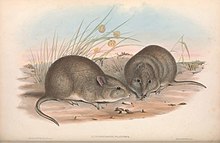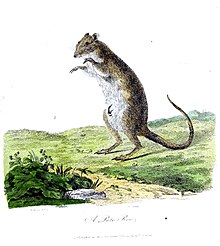Potoroo
| Potoroos[1] | |
|---|---|

| |
Potorous platyops
| |
| Scientific classification | |
| Domain: | Eukaryota |
| Kingdom: | Animalia |
| Phylum: | Chordata |
| Class: | Mammalia |
| Infraclass: | Marsupialia |
| Order: | Diprotodontia |
| Family: | Potoroidae |
| Subfamily: | Potoroinae
|
| Genus: | Potorous Desmarest, 1804.[2] |
| Type species | |
| Didelphis murina | |
| Species | |
| |
Potoroo is a common name for species of Potorous, a
Potoroos were formerly very common in Australia, and early settlers reported them as being significant pests to their crops.
Status
Gilbert's potoroo was first described in the West in 1840 by naturalist John Gilbert. It was then thought to have become extinct until being rediscovered in 1994 at the Two Peoples Bay Nature Reserve (near Albany) in Western Australia. Conservation efforts have grown an initial wild population of 30–40 to over 100.[3] All species of Potorous are well within the "critical weight range" for mammals in Australia, those weighing from 35 to 4,200 grams (0.077 to 9.3 lb; 1.2 to 150 oz) whose trajectory was toward decline or extinction during British settlement.[4]
Taxonomy
A genus of smaller
The genus was named Potorous by
The common names for the species include rat-kangaroo, kangaroo rat, and potoroo.
Classification
The genus is allied with the extant
A conservative arrangement with allied modern and fossil genera may be summarised as:[7]
- family Potoroidae
- subfamily †Palaeopotoroinae
- subfamily Potoroinae
- genus Aepyprymnus
- genus Bettongia
- genus †Borungaboodie
- genus †Milliyowi
- genus Caloprymnus† modern extinction
- genus Potorous
- P. gilbertiiGilbert's potoroo
- P. longipesLong-footed potoroo
- P. platyopsBroad-faced potoroo, † modern extinction
- P. tridactylusLong-nosed potoroo
- genus †Purtia
- genus †Wakiewakie
- genus †Gumardee
- genus
- subfamily †Bulungamayinae
- subfamily †
Description
The long-nosed potoroo sniffs the ground with a side to side motion near the vicinity of food. Once the long-nosed potoroo has located a possible food source (with its sense of smell), it positions itself to begin excavating with its fore paws.[8]
The skull of potoroos may be either narrow and elongated, as in the extant P. gilbertii, P. longipes, P. tridactylus, or broad and flattened, a feature of the extinct P. platyops. An external occipital crest is strongly defined, particularly in the males, and there is no apparent sagittal crest in the species cranial morphology. Potorous skulls have shallow and flattened
In popular culture

The first depiction of a potoroo species was published in 1790 by John White in his Journal of a Voyage to Botany Bay, the caption describing the animal as a "Poto Roo". The artwork was produced by Sarah Stone.
References
- OCLC 62265494.
- . Vol. 24. Chez Deterville. p. 20.
- ^ "World's rarest marsupial fighting back". SBS News. December 2014.
- .
- S2CID 27723765.
- ^ a b Thomas, O. (1888). Catalogue of the Marsupialia and Monotremata in the collection of the British Museum (Natural History). London. p. 116.
{{cite book}}: CS1 maint: location missing publisher (link) - ^ ISBN 9780643093416.
- ^ Vernes, K., & Jarman, P. (2014). Long-nosed potoroo (Potorous tridactylus) behaviour and handling times when foraging for buried truffles. Australian Mammalogy, 36(1), 128. doi:10.1071/am13037
